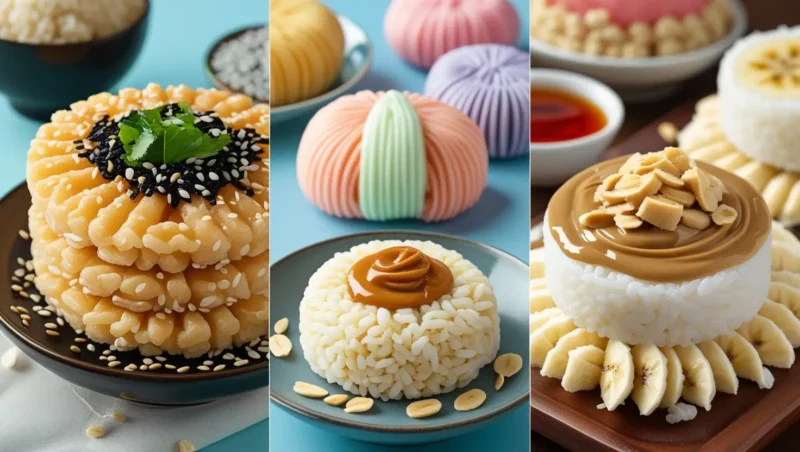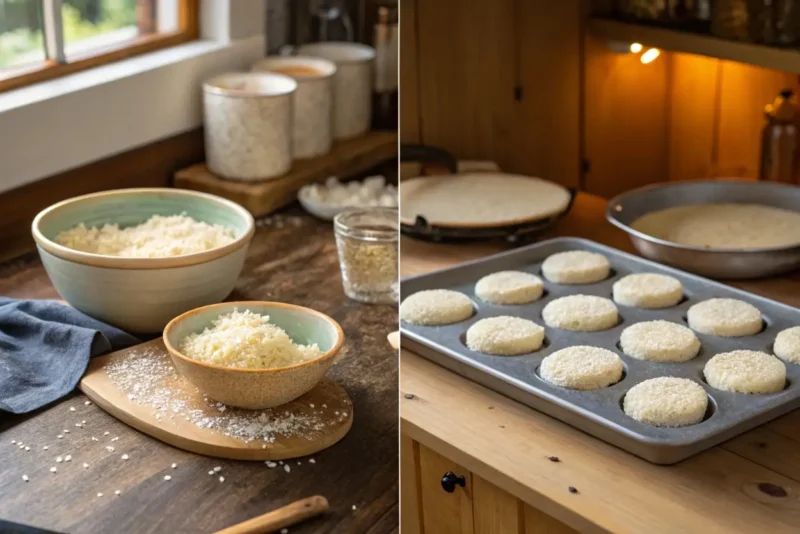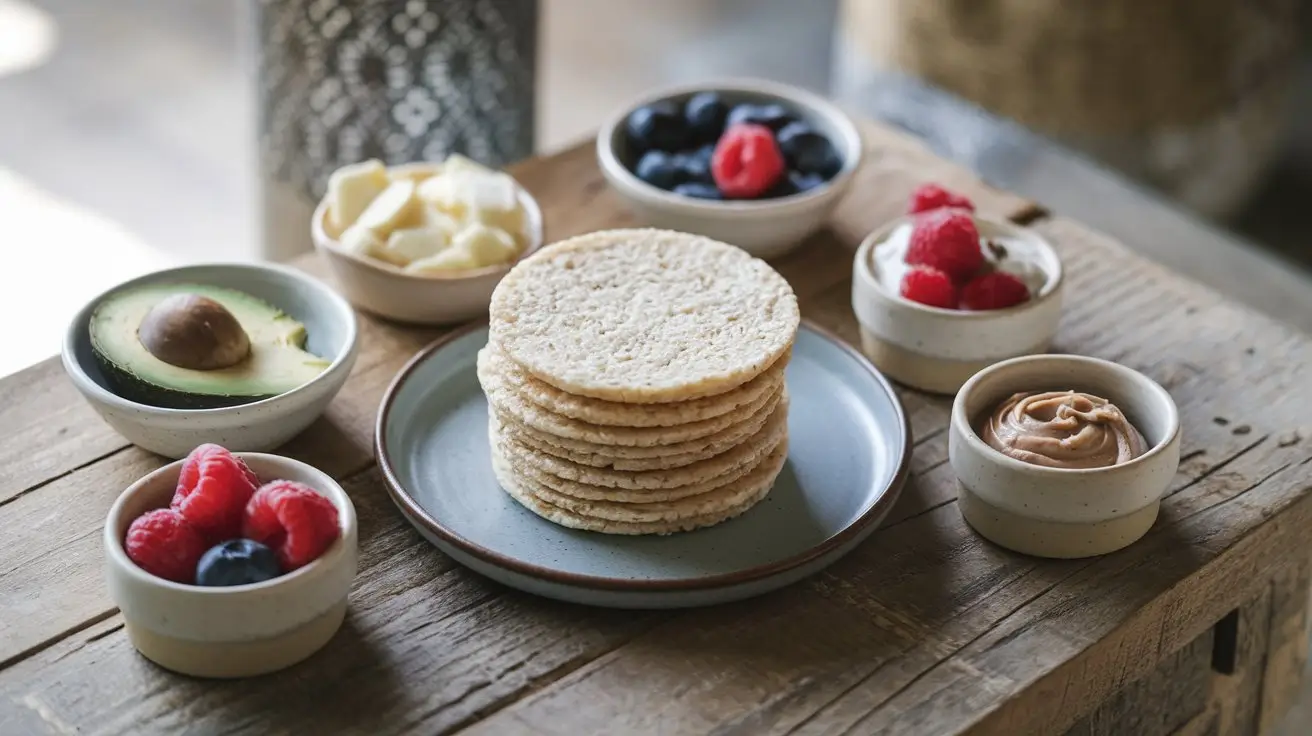That haves long been a popular snack choice across cultures and continents. Originating in Asia but embraced worldwide, these crunchy or chewy treats are made primarily from rice, offering a versatile and often healthy addition to any diet.
From their origins as an ancient culinary staple to their current status as a convenient snack option, rice cakes have undergone numerous transformations. Their appeal spans dietary preferences, as they are naturally gluten-free, low in calories, and adaptable to various flavors and cuisines. Whether you’re enjoying puffed rice cakes with a topping of avocado or indulging in the sticky-sweet rice cakes of Asia, their charm is universal.
Explore everything about this recipe, from their nutritional benefits to their cultural importance, and discover how to incorporate them into your diet with delicious recipes and creative ideas.
If you’re looking to enhance your breakfast options, consider pairing your rice cakes with avocado and egg for a nutritious start to the day.
Table of Contents
What Are Rice Cakes?
Rice cakes are simple snacks or food items made by pressing or puffing rice grains into compact, flat, or round shapes. Traditionally, they’re created without the use of additional fats or sugars, making them a natural, wholesome choice for those looking for light yet satisfying snacks.
Key Characteristics:
- Base Ingredient: Most rice cakes are made from whole-grain rice.
- Texture: Depending on the preparation, they can be crunchy (as in puffed varieties) or chewy (as in traditional Korean or Japanese rice cakes).
- Versatility: Available plain or flavored with sweet and savory seasonings.
For example, puffed rice cakes, like those sold under brands such as Quaker Rice Cakes, are known for their airy texture and suitability as a bread substitute. Meanwhile, traditional Korean rice cakes like tteok are chewy and often used in celebratory dishes.
Nutritional Value
Rice cakes are often chosen for their perceived health benefits, especially among those seeking low-calorie snacks. But are they truly healthy?
Macronutrient Breakdown:
- Calories: A single plain puffed rice cake has approximately 35 calories.
- Carbohydrates: High in carbs due to the primary ingredient, rice.
- Protein & Fat: Minimal amounts unless enhanced with toppings or fillings.
Micronutrients:
While plain rice cakes are not inherently rich in vitamins, fortified varieties can contain B vitamins and minerals like iron and zinc.
Tip: Pair rice cakes with nutrient-dense toppings such as peanut butter or hummus to enhance their nutritional value.
According to resources like Healthline, rice cakes are a great snack option but work best when complemented by protein or healthy fats.
Rice cakes are loved for being light and gluten-free, making them an excellent choice for snack enthusiasts. For more gluten-free snack inspirations, visit our gluten-free donuts guide to expand your options.
Types of Rice Cakes
Puffed Rice Cakes
Made by subjecting rice grains to heat and pressure, creating a crunchy, airy texture.
Korean Tteok
Sticky, dense rice cakes crafted with glutinous rice flour, often enjoyed with savory or sweet additions.
Japanese Mochi
Known for their soft, chewy texture, these are often filled with sweet pastes or served plain during celebrations.
Specialty Flavors
Rice cakes now come in a variety of flavors, from seaweed-infused to chocolate-covered. Specialty brands often target specific dietary niches, offering vegan, organic, and sugar-free options.
How Are Rice Cakes Made?
The process of creating rice cakes varies significantly depending on the type:
- Puffed Rice Cakes:
- Rice grains are pressurized and heated until they expand and stick together.
- Once puffed, they’re molded into flat or round shapes.
- Traditional Tteok or Mochi:
- Glutinous rice is soaked, steamed, and pounded to form a sticky dough.
- The dough is then shaped into desired forms.
- Home Preparation:
If you’re feeling adventurous, homemade rice cakes can be a rewarding culinary project. Start with cooked rice and use a press or mold to shape your cakes. Baking or lightly frying them ensures crispness.
Benefits of Rice Cakes
Low-Calorie Option
At only 30-50 calories per cake, they’re a guilt-free snack choice.
Dietary Versatility
Their neutral flavor makes them adaptable to both sweet and savory recipes.
Gluten-Free
Naturally gluten-free, rice cakes cater to those with celiac disease or gluten intolerance.
Quick and Convenient
Portable and easy to store, rice cakes are a practical snack for busy lifestyles.
Did You Know? In some cultures, rice cakes are believed to symbolize prosperity and good fortune.
Rice Cakes in Different Cultures

Rice cakes play a significant role in culinary traditions around the world.
Korea
Tteok is central to Korean celebrations, often served during weddings, New Year’s, and ancestral rites.
Japan
Mochi, crafted from pounded rice, is a staple during the New Year and other festivals.
India and Southeast Asia
Spiced rice cakes or crispy rice snacks like idli and murukku are common in daily diets.
These diverse forms reflect the adaptability of rice cakes, transcending boundaries to fit local tastes and traditions.
Are Rice Cakes Healthy?
While often perceived as a diet-friendly option, their healthiness depends on how they’re consumed.
Advantages
- Low in calories.
- Gluten-free.
- Free from artificial additives (in plain varieties).
Potential Downsides
- Low protein and fiber content.
- High glycemic index, potentially causing blood sugar spikes.
Rice Cakes for Weight Loss
Rice cakes are a favorite among dieters due to their low-calorie count. However, to maximize their effectiveness:
- Combine with protein-rich toppings like hummus or smoked salmon.
- Opt for whole-grain varieties for added fiber.
- Avoid flavored rice cakes with added sugars or salts.
Creative Recipes

They are perfect as a canvas for creative culinary ideas.
Sweet Recipes
- Banana and Almond Butter Rice Cakes: Spread almond butter and add banana slices.
- Chocolate Drizzle Rice Cakes: Drizzle melted dark chocolate and sprinkle with sea salt.
Savory Recipes
- Avocado and Egg Rice Cakes: Top with smashed avocado and a boiled egg.
- Mediterranean Rice Cakes: Add hummus, cherry tomatoes, and feta cheese.
When hunger strikes, rice cakes are a blank canvas for creativity. Sweet recipes like banana and almond butter rice cakes are a hit. Alternatively, drizzle melted dark chocolate and sprinkle with sea salt for dessert.
If you enjoy decadent breakfast ideas, cinnamon roll French toast may also inspire your culinary adventures.
Experiment with various flavors to find your favorite combinations!
for Snacks
When hunger strikes, it’s a quick, healthy choice. Their portability and ability to pair with various toppings make them ideal for on-the-go snacking.
Pairing it with Toppings
Some popular topping ideas include:
- Protein-Rich: Peanut butter, cottage cheese.
- Vegetables: Sliced cucumber, tomatoes.
- Fruits: Blueberries, strawberries.
Gluten-Free and Vegan Appeal
As naturally gluten-free and vegan-friendly, rice cakes fit seamlessly into restrictive diets. Brands like Lundberg Family Farms cater to these niches with innovative products.
Rice Cakes vs Other Snacks
When compared to bread or chips, rice cakes come out as a lighter, healthier alternative.
Advantages Over Bread:
- Fewer calories.
- Longer shelf life.
Homemade recipe

Making thiem at home is simpler than it seems.
Steps
- Cook rice.
- Mold into desired shapes.
- Bake or lightly fry.
Homemade rice cakes ensure you control the ingredients and avoid additives.
Storing and Preserving
Tips for Freshness:
- Keep in an airtight container.
- Store away from moisture.
in Fitness Diets
Athletes often turn to this cakes for quick energy. Paired with protein shakes or nut butter, they make excellent pre- and post-workout snacks.
For fitness enthusiasts, they are a quick energy boost. Pair them with protein-rich spreads or enjoy them alongside our protein pudding for a balanced post-workout snack.
for Children
Kids enjoy rice cakes for their fun shapes and mild flavor. Add spreads like nut butter or yogurt to make them more appealing.
Festive Treats
Rice cakes also pair beautifully with festive themes. Dive into fun dessert ideas like our Hello Kitty cake recipe for celebratory occasions.
Choosing the Best
Key Tips:
- Check labels for whole-grain options.
Avoid artificial flavoring or excessive salt.
Allergen Concerns
Plain rice cakes are generally allergen-free but always check for cross-contamination warnings on packaged varieties.
Rice Cakes and Sustainability
Eco-conscious brands are prioritizing sustainable practices in rice cake production, reducing their environmental impact.
Common Myths
- “Rice cakes are always healthy.” Not all varieties are, especially flavored ones with added sugars.
- “They provide complete nutrition.” Rice cakes lack sufficient protein and fiber to serve as a standalone meal.
Frequently Asked Questions
How are rice cakes made?
They are produced through a fascinating process that varies depending on the type. The most common puffed rice cakes are created using a combination of heat and pressure. Here’s how it works:
- Selection of Rice: High-quality whole-grain or glutinous rice is chosen based on the desired texture and flavor.
- Puffing Process: Rice grains are heated under high pressure, causing them to expand and bind together without needing additives.
- Shaping: The puffed rice is pressed into molds to achieve its iconic flat, circular shape.
- Baking or Drying: To enhance shelf life and crispness, the cakes are baked or dried.
For traditional rice cakes, like Korean tteok or Japanese mochi, the process involves steaming glutinous rice, pounding it into a smooth, sticky dough, and shaping it into forms. These varieties often retain the rice’s natural chewiness and are typically handmade for cultural dishes.
Are rice cakes good for weight loss?
Yes, rice cakes are widely regarded as a weight-loss-friendly snack due to their low-calorie content. However, their effectiveness depends on how they’re consumed:
- Plain Rice Cakes: Alone, they’re low in calories but also low in essential nutrients like fiber and protein. This means they may not keep you full for long.
- With Toppings: Pairing rice cakes with healthy toppings like nut butter, avocado, or lean proteins adds nutrients and keeps you satisfied longer.
For weight loss, it’s essential to balance rice cakes with other whole foods. They’re an excellent alternative to calorie-dense snacks but shouldn’t replace meals or nutrient-rich foods.
Can rice cakes replace bread?
Rice cakes can substitute for bread in certain scenarios, especially as a lighter, gluten-free option. For example:
- As a Base for Sandwiches: Use larger rice cakes to make open-faced sandwiches topped with hummus, vegetables, or deli meat.
- For Snacks: Replace crackers or bread with rice cakes for a lighter option that pairs well with dips or spreads.
However, rice cakes lack the substantial fiber, protein, and complex carbohydrates found in whole-grain bread. They’re best suited for snacks or small meals rather than as a complete replacement.
Do rice cakes contain gluten?
Plain rice cakes are naturally gluten-free, as they’re made from rice, which does not contain gluten. This makes them an excellent option for individuals with celiac disease or gluten sensitivity.
When purchasing flavored or packaged varieties, however, it’s important to check labels for:
- Cross-Contamination: Some brands may process rice cakes in facilities that handle wheat or gluten-containing ingredients.
- Added Ingredients: Flavored options might include gluten-containing seasonings or coatings.
Look for products labeled “Certified Gluten-Free” for added assurance.
What is the best way to store rice cakes?
Proper storage is key to maintaining the crispness and freshness of rice cakes. Follow these tips to ensure longevity:
- Airtight Containers: Transfer rice cakes into a resealable bag or airtight container to prevent exposure to air and moisture.
- Cool, Dry Place: Store them away from direct sunlight, heat, or humidity, which can cause them to become stale or soggy.
- Avoid Refrigeration: While it may seem logical, refrigeration can introduce moisture, making the cakes lose their crunch.
For best results, consume rice cakes within the recommended time frame on the packaging. Homemade rice cakes should be stored similarly but enjoyed sooner as they lack preservatives.
The Timeless Appeal of Rice Cakes
Rice cakes are more than just a snack; they are a symbol of culinary diversity and adaptability. Their global roots, from the chewy mochi of Japan to the celebratory tteok of Korea, showcase their cultural significance. In modern diets, rice cakes shine as a gluten-free, low-calorie option that complements a wide range of toppings and flavors.
Whether you enjoy them as a quick snack, a bread alternative, or part of a creative recipe, rice cakes cater to everyone. Their simplicity allows for endless customization—think avocado and egg for breakfast, peanut butter and banana for a post-workout snack, or chocolate drizzle for a dessert treat.
As a blend of tradition and innovation, rice cakes remain a staple for health-conscious individuals and food enthusiasts alike. Embrace their versatility and discover how they can elevate your snacking game. Enhance your snacking game with complementary dishes like our chicken and shrimp recipe or by exploring more innovative gluten-free treats.

